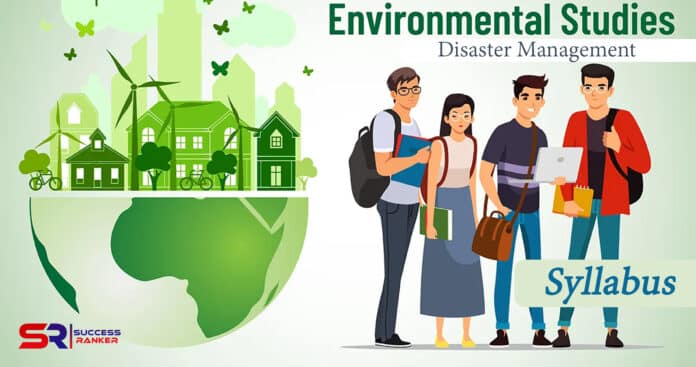BTEUP Environmental Studies & Disaster Management Syllabus 2024
The Board of Technical Education Uttar Pradesh (BTEUP) recognizes the critical importance of Environmental Studies and Disaster Management in shaping responsible and well-informed professionals. These subjects not only impart knowledge about the environment but also equip students with the skills to respond effectively in the face of unforeseen calamities. This article provides a comprehensive overview of the syllabi for Environmental Studies and Disaster Management offered by BTEUP.
BTEUP Environmental Studies & Disaster Management Syllabus
1. Introduction (05 Periods)
Basics of ecology, ecosystem- concept, and sustainable development, Resources renewable and non-renewable. Global Warming, Green House Effect, Acid Rain, Concept Of Green Building
पारिस्थितिकी की मूल बातें, पारिस्थितिकी तंत्र- अवधारणा, और सतत विकास, संसाधन नवीकरणीय और गैर-नवीकरणीय। ग्लोबल वार्मिंग, ग्रीन हाउस प्रभाव, एसिड रेन, ग्रीन बिल्डिंग की संकल्पना।
2 . Air Pollution (05 Periods)
Source of air pollution. Effect of air pollution on human health, economy, plant, and animals. Air Pollution Control Methods. Introduction to Air Pollution and its Prevention and Control Act 1981 & Environmental Protection Act 1986 and Function of State Pollution Control Board and National Green Tribunal (NGT).
वायु प्रदूषण का स्रोत. मानव स्वास्थ्य, अर्थव्यवस्था, पौधे, जानवरों पर वायु प्रदूषण का प्रभाव। वायु प्रदूषण नियंत्रण के तरीके. वायु प्रदूषण और इसकी रोकथाम और नियंत्रण अधिनियम 1981 और पर्यावरण संरक्षण अधिनियम 1986 का परिचय और राज्य प्रदूषण नियंत्रण बोर्ड और राष्ट्रीय हरित न्यायाधिकरण (एनजीटी) के कार्य।
3. Water Pollution (08 Periods)
Impurities in water, Cause of water pollution, Source of water pollution. Effect of water pollution on human health, Concept of dissolved O2, BOD, COD. Prevention of water pollution. Introduction to Water (Prevention and Control of Pollution) Act 1974.
जल में अशुद्धियाँ, जल प्रदूषण का कारण, जल प्रदूषण का स्रोत। मानव स्वास्थ्य पर जल प्रदूषण का प्रभाव, घुलित O2, BOD, COD की अवधारणा। जल प्रदूषण की रोकथाम. जल (प्रदूषण की रोकथाम और नियंत्रण) अधिनियम 1974 का परिचय।
4. Soil Pollution (06 Periods)
4.1 Sources of Soil Pollution
4.2 Types of Solid Waste- Household, Hospital, Agriculture, Biomedical, Animal waste and human waste, sediments and E-waste, and Plastic Waste.
4.3 Effect of Solid Waste
4.4 Disposal of Solid Waste- Solid Waste Management
4. मृदा प्रदूषण
4.1 मृदा प्रदूषण के स्रोत
4.2 ठोस अपशिष्ट के प्रकार – घरेलू, अस्पताल, कृषि, बायोमेडिकल, पशु से अपशिष्ट और मानव अपशिष्ट, तलछट और ई-कचरा, प्लास्टिक अपशिष्ट।
4.3 ठोस अपशिष्ट का प्रभाव
4.4 ठोस अपशिष्ट का निपटान – ठोस अपशिष्ट प्रबंधन
5. Noise pollution (03 Periods)
Source of noise pollution, Unit of noise, Effect of noise pollution, Acceptable noise level, and Different methods of minimize noise pollution.
5. ध्वनि प्रदूषण
ध्वनि प्रदूषण का स्रोत, शोर की इकाई, ध्वनि प्रदूषण का प्रभाव, स्वीकार्य शोर स्तर, ध्वनि प्रदूषण को कम करने के विभिन्न तरीके।
6. Disaster Causes And Hazards (5 Periods)
6.1 Introduction
6.2 Classification of Natural Disasters
6.3 Classification of Natural Disasters in India
6.3.1. Earthquake
6.3.2. Tsunami
6.3.3. Flood
6.3.4. Drought
6.3.5. Land Slide
6.3.6. Thunderstorm and Lightening
6. आपदा के कारण और खतरे
6.1 परिचय
6.2 प्राकृतिक आपदाओं का वर्गीकरण
6.3 भारत में प्राकृतिक आपदाओं का वर्गीकरण
6.3.1. भूकंप
6.3.2. सुनामी
6.3.3. बाढ़
6.3.4. सूखा
6.3.5. भूस्खलन
6.3.6. आंधी और बिजली
7. Disaster Management (10 Periods)
7.1 Framework
7.1.1 Yokohama Strategy for a Safer World (1999)
7.1.2 The Hyogo Framework for Action (HFA) (2005-2015)
7.1.3 Sendai Framework for Action (SDGS) (2015-2030)
7.2 Disaster Management, Preparedness and Response in India
7.2.1 National Disaster Management Authority (NDMA) Guidelines
7.2.2 National Policy on Disaster Management (2009)
7.2.3 National Disaster Management Act (2005)
7.2.4 NDRF (National Disaster Response Force), SDRF (State Disaster Response Force), DDRF (District Disaster Response Force), and Aapda Mitra.
7.2.5 Case studies of disaster management efforts: COVID-19 Pandemic, Earthquakes, Firefighting, Thunder Storm and Lightning.
7. आपदा प्रबंधन
7.1 रूपरेखा
7.1.1 सुरक्षित विश्व के लिए योकोहामा रणनीति (1999)
7.1.2 ह्योगो फ्रेमवर्क फॉर एक्शन (एचएफए) (2005-2015)
7.1.3 सेंदाई फ्रेमवर्क फॉर एक्शन (एसडीजीएस) (2015-2030)
7.2 भारत में आपदा प्रबंधन, तैयारी और प्रतिक्रिया
7.2.1 राष्ट्रीय आपदा प्रबंधन प्राधिकरण (एनडीएमए) दिशानिर्देश
7.2.2 आपदा प्रबंधन पर राष्ट्रीय नीति (2009)
7.2.3 राष्ट्रीय आपदा प्रबंधन अधिनियम (2005)
7.2.4 एनडीआरएफ (राष्ट्रीय आपदा प्रतिक्रिया बल), एसडीआरएफ (राज्य आपदा प्रतिक्रिया बल), डीडीआरएफ (जिला आपदा प्रतिक्रिया बल), और आपदा मित्र।
7.2.5 आपदा प्रबंधन प्रयासों का केस अध्ययन: कोविड-19 महामारी, भूकंप, अग्निशमन, गरज के साथ तूफान और बिजली गिरना।

